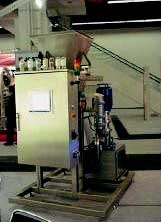| 2004 |

|
YEAR BOOK |
Teagasc � Dairy Products Research Centre, Moorepark, Fermoy, Co. Cork
|
Chemical conversion of acid casein to caseinate under low moisture reaction conditions
|

In practice, the conversion of acid casein to the caseinate form may be carried out from either of two starting points � fresh acid casein curd or dried acid casein. In either case, hydrated or rehydrated casein curd is suspended and neutralised using mixing conditions aimed at optimising particle size reduction and viscosity control. However, due to upper viscosity limits associated with spray atomisation, the maximum solids content of protein slurry preparations must be maintained relatively low (~25%), and consequently the water evaporation during spray drying is considerable. Because of the commodity nature of casein and caseinates, there are ongoing efforts at trying to reduce production costs or establish alternative methods of protein conversion.
The application of alternative technologies relies on performing neutralisation as a chemical reaction conducted under low moisture conditions. The preferred starting material in this instance is pre-dried acid casein, which is rewetted sufficiently (usually from the aqueous alkali source) for reaction to be accomplished. The challenge, therefore, is to ensure completeness of the chemical conversion. Trials were successfully carried out in Moorepark using a Schugi 160 continuous wet mixer/ agglomerator (Hosokawa Micron B.V., Holland) for casein conversion. Both dried acid casein and alkali (e.g. 15% w/w NaOH) were metered accurately into a specially-designed mixing chamber, where the powder particles were subjected to intensive mixing after contact with alkali. The flexible-walled chamber was continually massaged by externally-mounted mechanical rollers so that there was complete discharge of the thin powder layer formed on the inner wall. An additional feature is that the resulting powder is discharged from the chamber not alone neutralised, but also in agglomerated form. Agglomerated caseinate lends itself to greater ease of reconstitution.
The final step in the process requires the evaporation of the added water by means of fluidised bed drying in order to bring the product into line with typical caseinate moisture (5%) specification. The resulting powders compared well with spray dried equivalents in terms of solubility. Careful attention to the manner with which such processes are carried out is needed in order to meet specific end-product functionality.
Contact: Dr John Mounsey, Dr Phil Kelly & Dr Brendan O'Kennedy;
Tel: 025 42443; E-mail: [email protected]